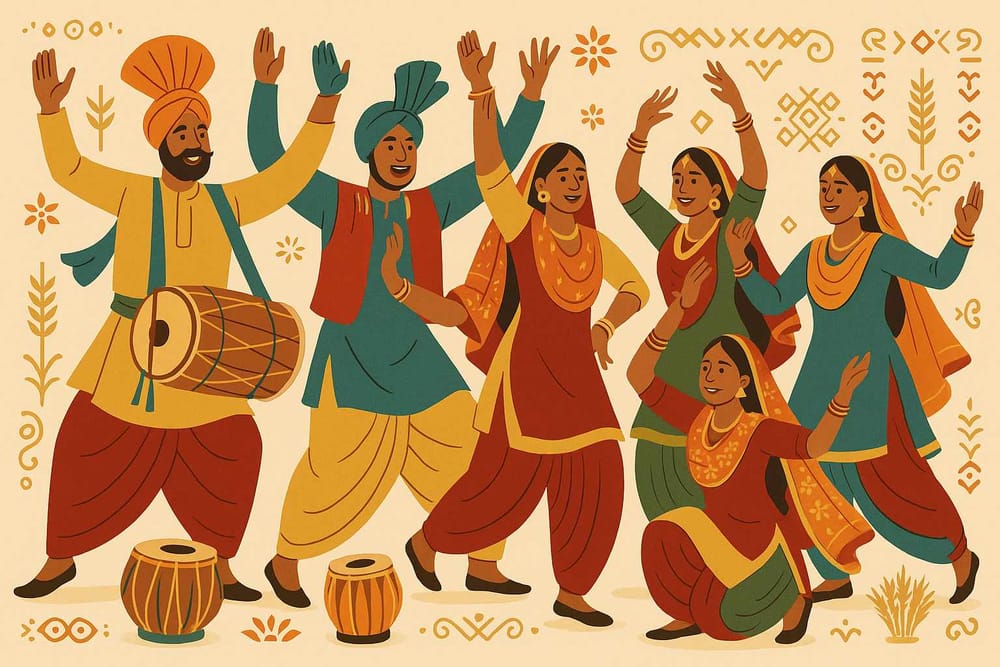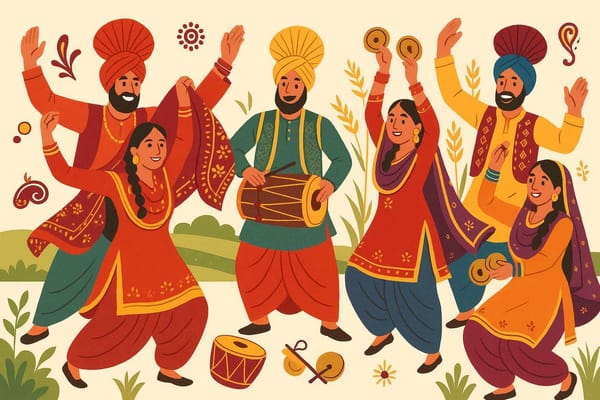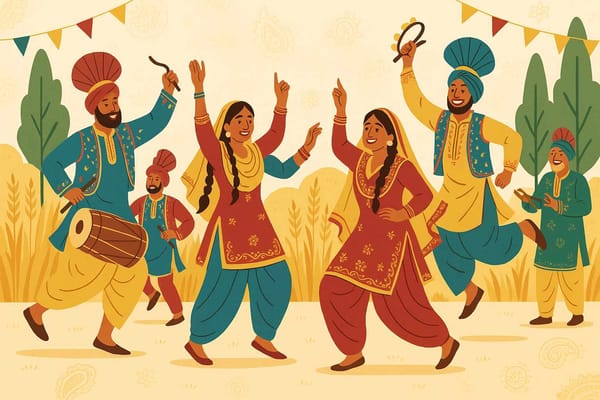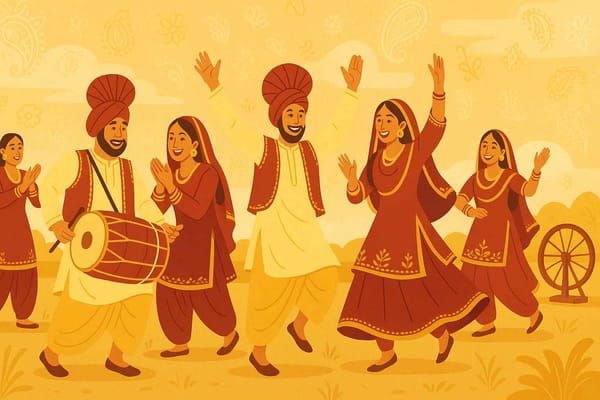
The Vibrant Rhythms of Punjab- A Guide to Folk Dances
Have you ever felt the air crackle with energy, the ground thrumming with the beat of a dhol? Have you seen a whirlwind of colours—bright turbans and shimmering phulkaris—and felt an irresistible urge to join in the celebration? That, my friend, is the magic of Punjab's folk dances. This isn't just about entertainment; it's the very heartbeat of Punjabi life, a vibrant expression of joy, hard work, and a spirit that never gives up.
In Punjab, dance isn't something you just watch; it's something you live. It’s woven into the very fabric of daily existence, marking everything from the golden harvest of Baisakhi to the joyous union of a wedding. Each step tells a story, each rhythm carries an emotion, and every performance brings the community together in a circle of shared happiness.
The Essence That Breathes Life into Every Move
Before we dive into the different forms, it's important to understand what makes these dances so special. The costumes are a feast for the eyes—dazzlingly bright outfits with intricate embroidery and traditional jewellery that sparkle with every turn. The air fills with the powerful sounds of instruments like the dhol (a large barrel drum), the soulful tumbi (a single-stringed instrument), and the rhythmic chimta (a pair of tongs with cymbals).
But more than anything, these dances are living traditions. They are passed down from one generation to the next, not through written manuals, but through shared experience, observation, and oral tradition. This is how the authentic movements and the poetic verses, known as boliyan, have remained pure and alive, echoing the sweet dialect of Punjab through the ages.
A Tour of Punjab's Most Cherished Folk Dances
Punjab's treasure trove of folk dances is rich and varied. While they all share a common thread of joy, each has its own unique flavour and story.
Kikli: The Innocent Twirl of Friendship
A simple yet utterly delightful dance, Kikli is usually performed by two young women. They cross their arms, hold hands, and spin around as fast as they can, their dupattas flying in a riot of colour, all while singing folk songs. Kikli is a beautiful representation of friendship, youth, and the simple joys of life, reminding us of carefree childhood days.
Sammi: An Echo of Ancient Legends
Sammi is a beautiful tribal dance form that tells the story of a girl named Sammi who longed for her beloved. Performed by women in colourful kurtas and lehengas, the dance is characterised by its gentle, circular movements and swaying arms. It has a certain nostalgic charm, carrying with it the folklore and ancient traditions of the land, making it a truly unique and heartfelt performance.
Luddi: The Dance of Uninhibited Triumph
Luddi is the dance you do when you have a victory to celebrate! Traditionally performed by men to mark a success, whether in a competition or in life, this dance is all about expressing pride and happiness. The movements are energetic, with performers snapping their fingers, clapping, and moving their shoulders with infectious enthusiasm. It’s a pure, unadulterated expression of success and collective joy.
Jhumar: The Gentle Sway of the Soul
Originating from the Sandalbar region of Punjab, Jhumar is a dance that moves at a slower, more deliberate pace. The name itself means "to sway," and that's exactly what the dancers do—move in a graceful, circular motion that feels deeply connected to the earth. Often performed at weddings and Sufi gatherings, Jhumar is a dance of emotion, its gentle rhythm reflecting a sense of peace, love, and spiritual connection. It’s mesmerising to watch, drawing you into its calm and soulful world.
Giddha: A Graceful Circle of Stories and Laughter
If Bhangra is the thunder, Giddha is the graceful rain that follows. Performed by women, this dance is a beautiful spectacle of synchronised clapping, elegant spins, and playful storytelling. The heart of Giddha lies in the boliyan, witty couplets sung to narrate everything from daily chores and mother-in-law banter to tales of love and longing. It’s a dance of sisterhood, where women come together to share their lives through rhythm and rhyme.
Bhangra: The Global Heartbeat of Celebration
Bhangra is more than a dance; it's an explosion of pure joy. Originating as a way for farmers to celebrate a bountiful harvest, its energetic leaps, powerful shoulder shrugs, and infectious rhythm have made it a worldwide phenomenon. When the dhol starts to beat, it’s a call to let go of your worries and celebrate life with all your might. Today, you hear its beats everywhere, from grand weddings to Bollywood blockbusters, carrying the undiluted spirit of Punjab across the globe.
More Than Steps: A Living, Breathing Heritage
Punjabi folk dances are not just museum pieces; they are a vital part of the culture that continues to evolve. They serve as living archives, preserving stories of history, love, and everyday life through their movements and songs. These performances are central to what makes us understand that folk music and dance define culture, acting as a bridge between the past and the present.
They bring entire villages together, strengthening community bonds during festivals and family functions. Today, the Punjabi diaspora has taken these traditions across the world, ensuring that the sound of the dhol and the grace of Giddha are celebrated from Canada to Australia, keeping the connection to their roots alive and strong.
Curious to Know More?
What really sets Bhangra and Giddha apart?
While both are celebratory, the main difference lies in who performs them and their expressive style. Bhangra is predominantly a high-energy dance for men, showcasing strength and vigour. Giddha, on the other hand, is a graceful and narrative dance performed by women, using clapping and boliyan to tell stories.
Is special attire necessary for these dances?
Absolutely! The traditional costumes are integral to the performance. For Bhangra, men wear a bright kurta, a chadar or lungi tied around the waist, and a colourful pagri (turban). For Giddha, women wear vibrant salwar kameez, often with a beautiful embroidered phulkari dupatta and traditional jewellery, which adds to the visual poetry of the dance.
Are these dances only for festivals?
Not at all! While major festivals like Baisakhi are a prime time for performances, these dances are a part of almost every happy occasion in Punjab. You'll see them at weddings, birth celebrations, and any social gathering where there is joy to be shared.
Just as these dances carry the soul and stories of a culture, we at Bhaktilipi believe in preserving the timeless tales of India's spiritual heritage. Our mission is to share this profound wisdom in a way that connects with you today.
At Bhaktilipi.in, we bring you devotional literature, inspiring stories, and insights into rituals that form the bedrock of our culture. We are a space where you can reconnect with your roots and explore the spiritual treasures of India with ease and authenticity.
Join our community and stay connected to our shared heritage. Follow us for your daily dose of inspiration and wisdom:
- Facebook: BhaktilipiOfficial
- Instagram: @bhakti_lipi
- YouTube: Bhaktilipi
A Rhythm That Will Echo Forever
From the powerful beats of Bhangra to the poetic grace of Giddha, the folk dances of Punjab are a vibrant testament to a culture that is full of life, warmth, and resilience. They are a celebration of community, a link to the past, and a joyous gift to the future. So the next time you hear the beat of a dhol, don't just listen—let the rhythm move you, and feel the incredible spirit of Punjab come alive.
A passionate group of people dedicated to preserving India's knowledge of Dharma, Karma, and Bhakti for ourselves and the world 🙏.
Comments
Related in

The Vibrant Folk Dances of Punjab- A Complete Guide
Close your eyes for a moment. Can you hear it? That distant, thunderous beat of a dhol? That sound is more than just music; it's the very heartbeat of Punjab. It’s a call to celebration that echoes through the golden mustard fields and bustling village squares. The

Exploring the Enchanting Folk Dances of Punjab - A 2025 Guide
There's a certain magic in the soil of Punjab, a land where golden fields stretch as far as the eye can see and the air hums with stories of courage and celebration. This vibrant energy, this zest for life, isn't just in its famous cuisine or

Punjab Folk Dances-A Vibrant Exploration
Close your eyes for a moment. Can you hear it? The powerful, infectious beat of a dhol that makes your heart thump in rhythm. Can you see it? A whirlwind of bright colours, joyous smiles, and feet that seem to defy gravity. This is the very essence of Punjab, a
